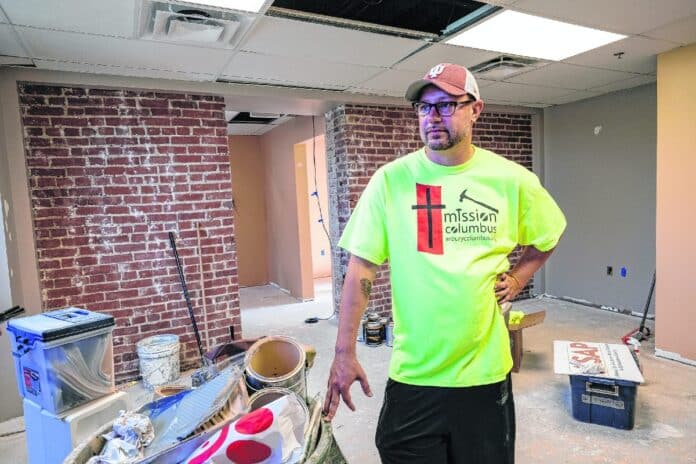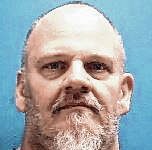
They moved walls, rewired, removed a gigantic brick safe and built a bridge in the floor — and soon the work of hundreds of volunteers and contractors will be finished with the opening of the Alliance for Substance Abuse Progress Hub.
Second coats of paint are being completed and soon the flooring will be installed, followed by volunteers who will bring in furniture for the Hub staff and clients. The new 1,600-square-foot facility will provide a physical location where people seeking addiction treatment will find referrals and assistance.
The offices are located in the former United Way of Bartholomew County office space in the Doug Otto Center at 1531 13th St., after United Way moved across the street to a renovated former Columbus fire station.
During the six-month month renovation process, more than 250 volunteers worked on the Hub project, donating more than 600 hours to the project.
[sc:text-divider text-divider-title=”Story continues below gallery” ]
Nathan Walsh, who is the HUB manager, volunteered his time working on the project, including working on the demolition of the safe.
“They got their hooks in me,” Walsh laughed when talking about working with Mission Columbus. “Not a bad group to get hooked into.”
The remodeling project, which began in March, was not without complications and challenges, said Steve Ferdon, of Mission Columbus, which has project-managed the office remodel, from demo to completion.
“It’s probably one of the more complicated projects we have done,” Ferdon said, as he walked through the newly refurbished rooms, offices and break rooms. “But really the most complicated work we did was after the flood of 2008.”
Ferdon allowed that from a technical standpoint, the Hub project required Mission Columbus structural engineers and volunteers to invent a lot of processes as they worked through the renovation.
But as Ferdon walked into what is being finished as the general gathering and meeting room for The Hub, he wasn’t the only one smiling at how expansive the large open space looks — now that it doesn’t have an enormous brick safe in the middle of the room.
That particular part of the demo, taking out an old Arvin Industries safe that was original to the building, was one of the most challenging parts of the renovation. But removing it revealed a far more spacious room and allowed new windows to let in natural light throughout the space.
The demolition of the safe revealed two immediate structural problems — the top of it was holding up the roof and the bottom, well, the demo revealed there was nothing underneath the floor supporting the bricks. After all the safe was demolished and removed, crews decided to drill through the floor just to see what the support was underneath the former safe. But all they found was fill dirt that had settled into a precarious support for the safe.
That’s where the bridge-building came in.
“What you have here is a bridge,” Ferdon said as he stood on the former imprint of the safe in the Hub floor, now covered in concrete. Using rebar and fiberglass-enforced concrete, the area where the safe stood is now the equivalent of a highway bridge filling the space.
The bridge will be covered with flooring, but Mission Columbus volunteers know just how sturdy that particular part of the floor is.
“You could drive a car across this now,” Ferdon said.
Ceiling beams, painted an attractive gray, were set in place to hold up the roof, and despite their structural necessity look attractive as they cross the ceiling.
The new space includes two conference rooms, one larger and one smaller, for private consultations, a planned internet cafe with computers donated by Family Service Inc. and a coffee bar with tables and stools donated by Cummins Inc.
Skilled tradesman from around the community donated their time as well, and some did materials and work at cost to save ASAP money on the project. Kenny Glass, Superior Drywall and other professional contractors have worked on the project. Donations of materials and labor have been crucial to the project, Ferdon said.
Carpeting is scheduled to go in this week, and Cummins Inc. employees from the Corporate Office Building will volunteer their time to put together furniture donated from Cummins from its remodel of the downtown headquarters.
ASAP officials were invited to pick out items that Cummins no longer planned to use after its remodeling for use in the Hub. Items include desks, overhead storage, tables, chairs and couches, which will now be part of the Hub.
The Ridge church offered to purchase new chairs and couches, telling Hub officials to pick out what they needed and send the invoice to the church.
In addition to new wiring throughout the offices, a security system including cameras will be installed, Walsh said. It is video only, not audio, and will provide additional safety for staff members, he said.
[sc:pullout-title pullout-title=”ASAP Hub staff” ][sc:pullout-text-begin]
Leaders for the ASAP Hub staff
Doug Leonard – executive director
The executive director works with the board of directors to establish ASAP goals and policies, and is responsible for ASAP strategy, communications, operations, staff and results.
Matthew Neville – operations and communications manager
The communications and operations manager is responsible for developing and maintaining all communication delivered by ASAP to clients, partners and the public, as well as oversees the financial, office management and IT functions of ASAP.
Nathan Walsh – ASAP Hub manager
The ASAP Hub manager is responsible for the start-up and ongoing operation of the ASAP Hub, hiring/managing the ASAP Hub staff and defining the policies and procedures necessary for operating a recovery resource center.
Tracey Clark – volunteer services manager
The volunteer services manager develops, updates and executes volunteer recruitment strategies and oversees the day-to-day volunteer program operations.
Tara Tiller Todd – health systems navigator
The health systems navigator is responsible for helping clients navigate the insurance marketplace, and supporting clients during their recovery journey.
[sc:pullout-text-end][sc:pullout-title pullout-title=”Where to learn more” ][sc:pullout-text-begin]
To learn more about the Alliance for Substance Abuse Progress, visit asapbc.org.
[sc:pullout-text-end][sc:pullout-title pullout-title=”About the ASAP Hub” ][sc:pullout-text-begin]
The Alliance for Substance Abuse Progress Hub, a centralized location to find services and help for those recovering from addiction, will be located in the Doug Otto Center building, 1531 13th St.
Organizers said the Hub will help bridge gaps in addiction treatment, assist with social services and offer a central location for anyone seeking sobriety or information about addiction.
“The Hub will be the place where men, women and families can get the information and support they need to start and maintain their recovery journey,” said Jeff Jones, executive lead for ASAP.
For more information, visit asapbc.org.
[sc:pullout-text-end][sc:pullout-title pullout-title=”About Mission Columbus” ][sc:pullout-text-begin]
To learn more about Mission Columbus, whose home base is Asbury United Methodist Church in Columbus, visit asburycolumbus.org/tag/mission-columbus/.
[sc:pullout-text-end]




